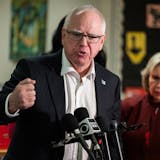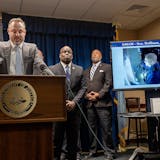Minnesota's hunger crisis is expected to worsen this summer and fall, as the number of residents in need of food help surges to levels not seen since the Great Depression.
The new projections released Wednesday by Second Harvest Heartland are the first to show the length of a growing need in the state driven by a deepening economic downturn brought on by the COVID-19 pandemic.
"We are going to see unprecedented need and really need unlike anything we've seen since the Great Depression," said Allison O'Toole, CEO of Second Harvest in Brooklyn Park, one of seven food banks that supply Minnesota food shelves. "We've been training all summer long for this steep climb."
The crisis has already strained Minnesota's 350 food shelves, with many seeing double or triple the normal levels of visitors since March, including an uptick in first-time users.
The new numbers from Second Harvest and consulting firm McKinsey & Co. predict the need for food assistance will peak in September to 735,000 Minnesotans who are "food insecure," or don't have consistent access to enough food. That's 13% of the state's population and 130,000 more people than after the 2008 recession.
"We have a strong emergency food system in Minnesota," said Colleen Moriarty, who heads the statewide advocacy group Hunger Solutions. "I think, all working together, we can meet the challenge."
Minnesota's unemployment rate rose to 9.9% last month, the highest level ever recorded since the state began tracking it in the 1970s. But the $600 a week that unemployed workers are receiving from the federal CARES Act ends July 31, so food shelves are bracing for an uptick in requests.
The new data account for that loss of $600 in federal aid and assume unemployment will peak in Minnesota at 18% this summer, with the hunger crisis continuing until the end of 2021 and the increased need costing the emergency food network $21 million.
![A black bear stopped after crossing Big Bay Road on Madeline Island, the largest of the Apostle Islands in Wisconsin, on Monday, May 31, 2021. ]](https://arc.stimg.co/startribunemedia/PWNYGIY3WTSWDBOGOYD775DPP4.jpg?&w=80&ar=1:1&fit=crop)


